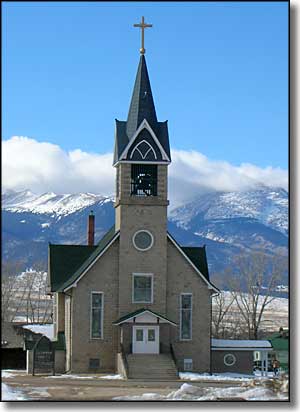 |
The Founding of Custer County, Colorado |
|
|
 Hope Lutheran Church in Westcliffe Like most of Colorado, what we call “Custer County's history” didn't begin until the Europeans arrived. The Spaniards first came through in the mid 1500's. When they didn't find much gold available here they moved on. They were followed by successive waves of French trappers. The Zebulon Pike Expedition in 1806-1807 was the first recorded entry into the valley by Americans. Then came folks like George Simpson, Uncle Dick Wootton, James Beckwourth, Joseph Doyle, and Kit Carson as trappers, hunters and guides. John Fremont came through the county in the company of Kit Carson in 1845. But the first pioneers to settle in the Wet Mountain Valley were Elisha P. Horn, John Taylor and William Vorhis in 1869. Mining began in 1863 in Hardscrabble Canyon with the discovery of high grade silver ore by Si and Stephen Smith in what became the Smith Mining District. The next find was in 1870 and resulted in the formation of the Hardscrabble Mining District in November of 1872. This was the town of Rosita, and Rosita peaked at over 1500 inhabitants in 1875 when two seemingly respectable businessmen, Walter Stuart and James Boyd, started an illegal mine takeover and sparked a violent war. When the smoke cleared it was discovered that Walter Stuart was really Walter C. Sheridan, one of America's most notorious forgers and bank robbers. And he had just left town with all but eighty cents of the Rosita Bank's money. As the mines were petering out anyway, that pretty much spelled the end of Rosita. A fire in 1881 almost levelled the entire town. Querida was the home of the Bassick Mine, a gold and silver producer that really came into its' own when Rosita was first being abandoned. In 1879, Edmund Bassick and his wife sold their majority shares in the mine to a group of New York investors. The management of these New Yorkers was overly strict and that led to a lot of gold ore being smuggled out of the mine and sold to local saloon keepers. These folks would then salt new mining claims with the stolen ore and sell those new claims to more New York investors. At a certain point, when a riot was imminent, the Bassick company men promised to "decorate the trees in the vicinity" with non-company men if the non-company men didn't leave the area immediately. Most left right away, and those who didn't were sent out of town in a wagon with instructions to never return. The Bassick mine was closed by 1885. Large cattle herds began arriving in 1870 with Edwin Beckwith, John Lapham and Bran & Co. As the valley was prime land for raising livestock and growing hay, by 1880 there were more than 13,000 head of cattle in Custer County. |
 Looking west across the Wet Mountain Valley to the Sangre de Cristo's |
 Formerly Silver Cliff Town Hall, now a museum As Rosita was being deserted, Silver Cliff was just getting started. By June of 1880, there were more than 5,000 people settled in Silver Cliff and at least another thousand were out combing the nearby hills for their own mineral finds. Then the Denver & Rio Grande arrived in 1881, ending their tracks about 1 mile west of Silver Cliff on some land the railroad builders had previously acquired. This became Westcliffe, and as Westcliffe was already planned out, the central part of town was built very quickly. By 1890, the gold and silver mines were nearly gone and Rosita, Querida and Silver Cliff were nearly gone, too. As the end of the rail line, Westcliffe survived as the county seat and supply center for local ranchers and farmers. |
|
|
Custer County Related PagesColorado Pages
Towns & Places - Scenic Byways - State Parks - BLM Sites - History & Heritage
Ski & Snowboard Areas - Photo Galleries - Colorado Mountains - Scenic Railroads Unique Natural Features - Wilderness Areas - Outdoor Sports & Recreation Colorado's National Forests - National Wildlife Refuges - Colorado's National Parks |
 |
| Index - Arizona - Colorado - Idaho - Montana - Nevada - New Mexico - Utah - Wyoming National Forests - National Parks - Scenic Byways - Ski & Snowboard Areas - BLM Sites Wilderness Areas - National Wildlife Refuges - National Trails - Rural Life Sponsor Sangres.com - About Sangres.com - Privacy Policy - Accessibility |
| Photos courtesy of Sangres.com, CCA ShareAlike 3.0 License. Text Copyright © by Sangres.com. All rights reserved. |